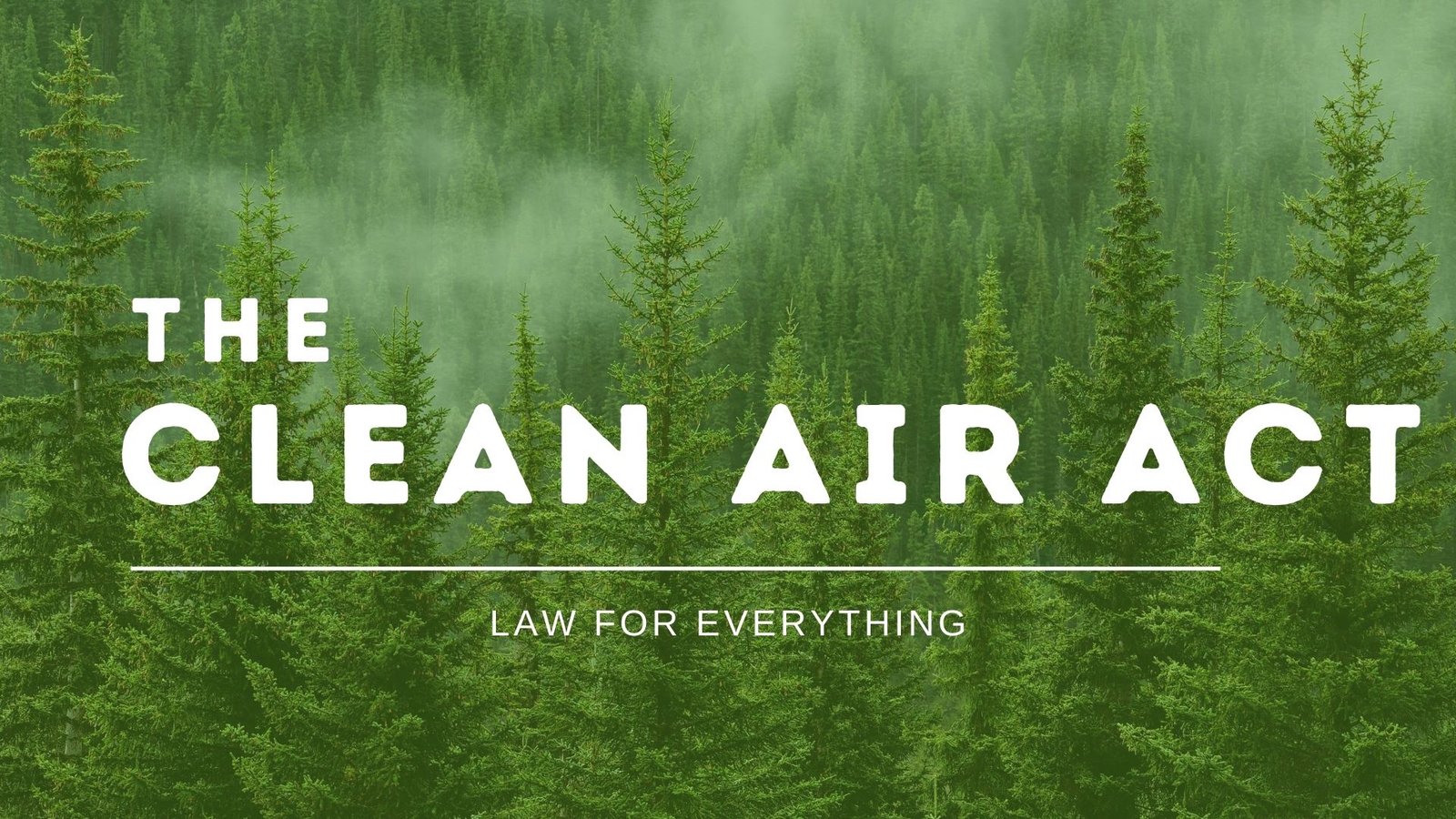On this page you will read detailed information about the Clean Air Act.
As an American citizen, you likely breathe cleaner air today than decades ago, thanks in large part to the Clean Air Act. This pivotal environmental law, which was originally passed in 1963 and strengthened through subsequent amendments, has led to dramatic improvements in air quality across the country by placing limits on certain air pollutants. Understanding the key provisions, amendments, and effects of the Clean Air Act provides insight into how impactful legislation can lead to real change. In this article, you will learn about the history and major components of the Clean Air Act, how amendments expanded its scope and effectiveness, and the measurable improvements in air quality and public health attributed to the law over the past fifty years. With this knowledge, you will better comprehend the vital role the Clean Air Act has played in the United States’ efforts to combat air pollution.
Overview of the Clean Air Act
The Clean Air Act (CAA) is one of the United States’ first and most influential modern environmental laws. Passed in 1963 and amended several times, the CAA authorizes the Environmental Protection Agency (EPA) to set limits on air pollution from stationary and mobile sources. The goal of the CAA is to protect public health and welfare by improving air quality across the country.
National Ambient Air Quality Standards
The CAA requires the EPA to set national ambient air quality standards (NAAQS) for harmful air pollutants to protect public health. The EPA has set NAAQS for six common pollutants: carbon monoxide, lead, nitrogen dioxide, particulate matter, ozone, and sulfur dioxide. The NAAQS are concentration levels for each pollutant that all areas of the country must meet. States are required to develop state implementation plans to achieve the NAAQS in their jurisdictions.
Hazardous Air Pollutants
In addition to the NAAQS, the CAA regulates emissions of hazardous air pollutants (HAPs), also known as air toxics. The EPA maintains a list of 187 HAPs, which are pollutants known or suspected to cause cancer or other serious health effects. The CAA requires major sources of HAPs to install maximum achievable control technology (MACT) to reduce emissions. The EPA can also set emissions standards for categories of stationary sources that emit HAPs.
In the previous post, we had shared information about An Overview of the Taft-Hartley Act of 1947, so read that post also
New Source Performance Standards
The CAA authorizes the EPA to set new source performance standards (NSPS), which are emissions standards for new or modified stationary sources of air pollution like power plants, refineries, and factories. The NSPS are intended to promote adoption of new emissions control technologies and pollution prevention measures. They help ensure that new or expanded industrial facilities use state-of-the-art controls to limit emissions.
The Clean Air Act has been remarkably successful in reducing air pollution and improving public health. Estimates show that the total benefits of the CAA exceeded costs by a ratio of more than 30 to 1 in 2020. The CAA will continue shaping air quality management and environmental policy in the U.S. for decades to come.
Key Provisions of the Original Clean Air Act
The Clean Air Act of 1970 established the basic structure of the national clean air program. Several key provisions aimed to curb both stationary and mobile sources of air pollution.
National Ambient Air Quality Standards (NAAQS)
The Clean Air Act authorized the Environmental Protection Agency (EPA) to establish national standards for air pollutants that may endanger public health or welfare. The EPA has set NAAQS for six common air pollutants: particulate matter, ozone, carbon monoxide, nitrogen oxides, sulfur dioxide, and lead. The NAAQS set permissible levels of these pollutants in the ambient air to protect human health and the environment.
State Implementation Plans (SIPs)
The Clean Air Act required states to develop SIPs that outline how each state will implement the NAAQS. The SIPs establish emissions limits and other control measures for pollution sources within each state. The EPA must approve each SIP, and states must revise them periodically to continue progress towards meeting the NAAQS.
New Source Performance Standards (NSPS)
The Clean Air Act directed the EPA to establish NSPS, emissions standards for new or modified stationary sources of air pollution. The NSPS set limits for emissions of particulate matter, sulfur dioxide, nitrogen oxides, and other pollutants from sources like power plants, refineries, and manufacturing facilities. The standards are based on the best demonstrated technology to limit emissions.
Mobile Source Emissions Standards
The original Clean Air Act also set the stage for regulating emissions from mobile sources by authorizing standards for motor vehicle emissions and fuels. In subsequent amendments, the Act established requirements for emissions standards for vehicles and programs like reformulated gasoline to curb pollution from the transportation sector.
The key provisions established in the 1970 Act created the foundation for controlling both stationary and mobile sources of air pollution in the United States. Subsequent amendments have built upon this foundation to strengthen clean air protections and further improve air quality.
Major Amendments to the Clean Air Act Over the Years
To strengthen the Clean Air Act and close loopholes, Congress has passed several amendments since 1970.
The 1977 Amendments
In 1977, Congress made the first set of major revisions to the CAA. It extended deadlines for compliance with NAAQS to allow states more time to develop implementation plans. The amendments also addressed prevention of significant deterioration in areas with clean air and visibility protection in national parks and wilderness areas.
The 1990 Amendments
The 1990 amendments made more extensive changes to the CAA. They expanded and modified provisions concerning attainment and maintenance of NAAQS, added new programs to curb acid rain and toxic air pollutants, and established a national permits program. The amendments also expanded enforcement authority and increased penalties for violations.
Mercury and Air Toxics Standards (MATS) Rule
In 2011, the EPA issued the MATS rule to limit emissions of toxic air pollutants from power plants, especially mercury, arsenic, chromium, and acid gases. The rule requires coal- and oil-fired power plants to install control technologies to reduce these toxic air pollutants. After some litigation, the U.S. Supreme Court upheld the rule in 2015.
Cross-State Air Pollution Rule (CSAPR)
The EPA issued the CSAPR in 2011 to control emissions of SO2 and NOx from power plants in upwind states that contribute to NAAQS violations in downwind states. The rule replaced the EPA’s 2005 Clean Air Interstate Rule (CAIR). After litigation, an amended CSAPR took effect in 2015. It requires 28 states in the eastern U.S. to reduce SO2 and/or NOx emissions that cross state lines.
In summary, Congress and the EPA have made several amendments and additions to strengthen the Clean Air Act over time. Continued progress in reducing air pollution and protecting public health depends on faithful and effective implementation of these provisions.
Positive Effects of the Clean Air Act on Air Quality
The Clean Air Act (CAA) has led to significant improvements in air quality across the United States since its enactment in 1970. The CAA set national ambient air quality standards (NAAQS) for six common air pollutants: carbon monoxide, lead, nitrogen dioxide, particulate matter, ozone, and sulfur dioxide. The EPA established limits for these pollutants based on human health and environmental impacts.
As a result of the NAAQS and other CAA programs, concentrations of air pollutants have dropped dramatically. According to the EPA, between 1970 and 2017, aggregate emissions of the six common pollutants decreased by 73%. Air quality has improved in nearly every county, and air pollution levels are lower despite significant economic growth and population increases.
Reduced Health Impacts
Cleaner air has direct health benefits for the public. Fine particulate matter, sulfur dioxide, nitrogen dioxide, and ozone pollution have all been linked to respiratory diseases and other health issues. By lowering levels of these pollutants, the CAA has prevented hundreds of thousands of premature deaths, according to EPA analyses. Fewer pollution-related deaths and illnesses also generate economic benefits from avoided health care costs and lost productivity.
Environmental Protection
In addition to health benefits, the CAA has led to better protection of ecosystems and the environment. Reduced deposition of pollutants like sulfur dioxide and nitrogen oxides helps prevent acid rain and protects water bodies, forests, and agricultural land. Lower levels of air toxics and ozone protect vegetation and crops. Visibility has also improved in many national parks and wilderness areas as particulate and sulfur dioxide emissions have declined.
While further progress is still needed, the Clean Air Act has been remarkably effective at improving air quality, reducing pollution, and protecting public health in the United States. Continued implementation and enforcement of the CAA will provide additional benefits for both human and environmental well-being.
Clean Air Act FAQs: Your Top Questions Answered
The Clean Air Act (CAA) is the comprehensive federal law that regulates air emissions from stationary and mobile sources. Its purpose is to protect public health and welfare by regulating emissions of hazardous air pollutants and other air pollutants. The CAA sets limits on certain air pollutants, including setting air quality standards for outdoor air. It also establishes regulations for controlling the emissions of hazardous air pollutants from major stationary sources.
The CAA regulates emissions of the following major air pollutants: particulate matter (PM), sulfur dioxide (SO2), nitrogen oxides (NOx), carbon monoxide (CO), ozone (O3), lead (Pb), and volatile organic compounds (VOCs). The CAA requires the Environmental Protection Agency (EPA) to set National Ambient Air Quality Standards (NAAQS) for pollutants that are considered harmful to public health and the environment.
The CAA is enforced in several ways:
I) The EPA establishes emissions standards for vehicles and engines, fuels, and stationary sources like power plants and factories. Regulated entities must comply with these standards.
II) States develop State Implementation Plans (SIPs) that outline how they will control air pollution to meet the NAAQS. The EPA must approve each SIP.
III) Permits are required for constructing or modifying stationary sources of air pollution. Operators must demonstrate that they will comply with emissions limits and other requirements before receiving a permit.
IV) Compliance monitoring and inspections are conducted to ensure regulated entities follow the law. Enforcement actions like fines can be taken against violators.
V) Citizens are empowered to file lawsuits against any person or entity allegedly violating the CAA.
The CAA has been successful in dramatically reducing air pollution in the United States since 1970. By following its comprehensive framework for controlling emissions and enforcing compliance, the nation’s air quality has steadily improved—leading to better health and environmental outcomes. Continued progress depends on the shared commitment of governments, businesses, and individuals to make further reductions in air pollution and transition to cleaner energy and transportation systems.
Conclusion
You have now gained a deeper understanding of the Clean Air Act and its provisions, amendments, and effects on air quality in the United States. This landmark environmental law has led to significant improvements in air pollution levels through nationwide emissions standards, regulation of hazardous air pollutants, acid rain control measures, and more. While challenges remain, the Clean Air Act demonstrates that dedicated policies and enforcement can produce meaningful change over time. As an engaged citizen, you can continue supporting clean air policies and efforts in your own community. Promoting awareness and advocating for ongoing progress will lead to cleaner, healthier air for all. Through dedication and perseverance, we can work together to fulfill the ultimate aims of the Clean Air Act.
Disclaimer
The information and services on this website are not intended to and shall not be used as legal advice. You should consult a Legal Professional for any legal or solicited advice. While we have good faith and our own independent research to every information listed on the website and do our best to ensure that the data provided is accurate. However, we do not guarantee the information provided is accurate and make no representation or warranty of any kind, express or implied, regarding the accuracy, adequacy, validity, reliability, availability, or completeness of any information on the Site. UNDER NO CIRCUMSTANCES SHALL WE HAVE ANY LIABILITY TO YOU FOR ANY LOSS OR DAMAGE OF ANY KIND INCURRED AS A RESULT OR RELIANCE ON ANY INFORMATION PROVIDED ON THE SITE. YOUR USE OF THE SITE AND YOUR RELIANCE ON ANY INFORMATION ON THE SITE IS SOLELY AT YOUR OWN RISK. Comments on this website are the sole responsibility of their writers so the accuracy, completeness, veracity, honesty, factuality and politeness of comments are not guaranteed.
So friends, today we talked about the Clean Air Act, hope you liked our post.
If you liked the information about the Clean Air Act, then definitely share this article with your friends.









